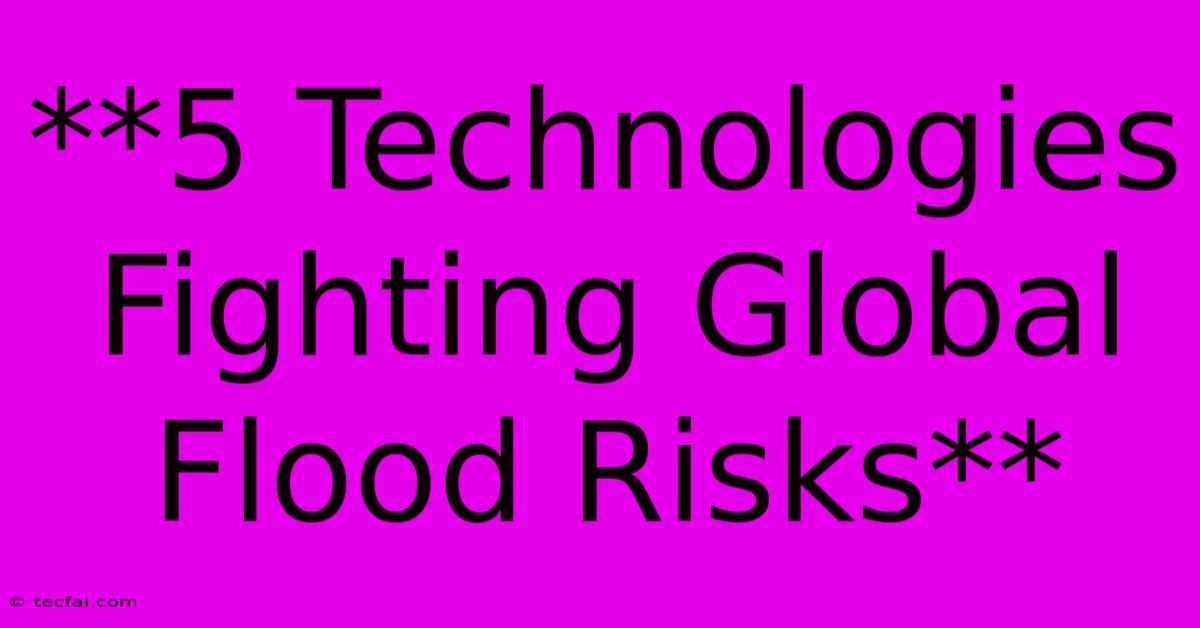**5 Technologies Fighting Global Flood Risks**

Discover more detailed and exciting information on our website. Click the link below to start your adventure: Visit Best Website tecfai.com. Don't miss out!
Table of Contents
5 Technologies Fighting Global Flood Risks
As climate change intensifies, the frequency and severity of floods are on the rise. This poses a significant threat to lives, property, and infrastructure globally. Thankfully, innovation is stepping up to the challenge, with new technologies offering innovative solutions to mitigate flood risks. Here are five such technologies that are making a difference in the fight against floods:
1. Early Warning Systems: Predicting the Inevitable
Early warning systems are crucial for preparing communities for impending floods. These systems leverage data from various sources like weather forecasts, river levels, and rainfall data to issue timely alerts, giving people enough time to evacuate or take preventative measures.
How it works:
- Sensors: Sensors strategically placed across river networks, rainfall gauges, and other vulnerable areas collect real-time data on water levels, rainfall intensity, and other relevant parameters.
- Data Processing: The collected data is processed and analyzed by sophisticated algorithms, taking into account historical data and weather forecasts to predict flood risks.
- Alert Systems: Once the system identifies a potential flood threat, it triggers alerts through various channels like mobile apps, SMS, and local sirens, reaching people in the affected areas.
Benefits:
- Improved preparedness and response time
- Reduced risk of casualties and property damage
- More efficient allocation of resources for flood mitigation
2. Flood-Resistant Infrastructure: Building for a Wetter Future
Traditional infrastructure is often ill-equipped to handle the increasing flood threats. Flood-resistant infrastructure is designed with resilience in mind, incorporating features that minimize damage and disruption during flood events.
Examples:
- Elevated structures: Buildings, roads, and utilities constructed on elevated platforms to minimize water inundation.
- Floodwalls and levees: Physical barriers to contain floodwaters and redirect them to safer areas.
- Stormwater management systems: Systems designed to collect and manage stormwater runoff efficiently, reducing the strain on drainage systems.
- Green infrastructure: Incorporating vegetation and natural features like wetlands to absorb and filter stormwater, slowing its flow and reducing flood risks.
Benefits:
- Reduced flood damage to infrastructure
- Improved public safety during flood events
- Increased resilience of communities to extreme weather events
3. Artificial Intelligence (AI): Predicting and Preventing Floods
AI plays a vital role in improving flood prediction and prevention strategies. With its ability to analyze vast amounts of data and learn from patterns, AI can help in:
- Accurate forecasting: AI algorithms can integrate real-time data from various sources to provide more accurate and timely flood predictions.
- Adaptive management: AI-powered systems can continuously learn and adapt to changing flood patterns, optimizing flood mitigation strategies based on evolving risks.
- Early detection and intervention: AI can identify early warning signs of potential flooding by analyzing satellite imagery, social media feeds, and other data sources.
Benefits:
- Enhanced flood preparedness and response
- More efficient use of resources for flood mitigation
- Reduction in economic and societal losses due to flooding
4. Drone Technology: Rapid Assessment and Response
Drones are proving to be invaluable tools for flood management, offering a range of capabilities:
- Rapid assessment: Drones equipped with high-resolution cameras can quickly assess flood damage and assess the extent of the affected areas.
- Real-time monitoring: Drones can provide live footage of flood conditions, aiding in evacuation efforts and emergency response.
- Delivery of aid: Drones can be used to deliver essential supplies like food, water, and medical equipment to isolated communities.
Benefits:
- Faster and more efficient flood response
- Enhanced situational awareness during flood events
- Reduced risk to human responders in dangerous flood situations
5. Sustainable Urban Planning: Mitigating the Problem at its Source
Sustainable urban planning plays a crucial role in reducing flood risks by addressing the root causes of flooding in urban areas.
Key principles:
- Green infrastructure: Incorporating green spaces like parks, wetlands, and green roofs to absorb and manage stormwater runoff.
- Water-sensitive urban design: Planning urban development with water in mind, including permeable pavements and rainwater harvesting systems.
- Flood risk mapping: Identifying areas at high risk of flooding and implementing appropriate planning strategies to minimize vulnerability.
Benefits:
- Reduced urban flooding and its consequences
- Improved water quality and overall environmental health
- Creation of more resilient and sustainable urban environments
Conclusion:
The fight against global flood risks demands a multifaceted approach, and technology is playing a crucial role in strengthening our defenses. From early warning systems and flood-resistant infrastructure to AI-powered solutions and drone technology, these innovations are empowering communities to adapt and thrive in the face of increasingly challenging flood events.

Thank you for visiting our website wich cover about **5 Technologies Fighting Global Flood Risks**. We hope the information provided has been useful to you. Feel free to contact us if you have any questions or need further assistance. See you next time and dont miss to bookmark.
Featured Posts
-
Driver Ng Suv Na May Pekeng 7 Plate Sumuko
Nov 06, 2024
-
Can Trump Vote In 2024 Election Law Explained
Nov 06, 2024
-
Oz True Crime Show Features Dark Scenes
Nov 06, 2024
-
Bagong Nike Zoom Vomero 5 Sa Dark Team Red
Nov 06, 2024
-
Champions League Sporting 4 1 City Huge Upset
Nov 06, 2024
